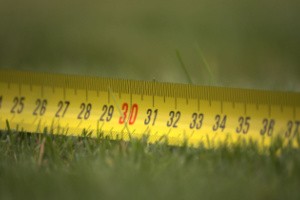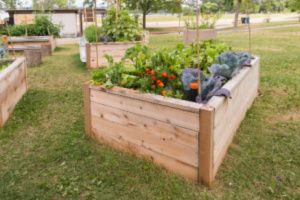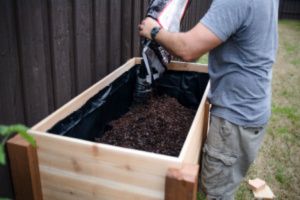A raised garden bed is a great way to get a healthy garden underway – even if you only have a limited amount of space. It allows you to plant earlier and tend a garden without bending over, and its confined space makes it easier to control pests.
For many people, however, the biggest draw is the chance to begin with the ideal soil blend. However, it is important to make sure you buy the right amount of soil to avoid multiple trips to the garden center or waste money on unneeded soil. Here is a look at how to determine the right amount of soil for your garden bed and other tips for raised garden bed success.
Measure and Calculate
If you already have a raised garden bed, you will only need a measuring tape and a calculator. Most soil is sold in bags bearing cubic feet measurements, so it is best to make your measurements in feet.

First, measure the length of your planter box across its longest edge and jot this number down on a piece of paper. Then, measure the planter box’s width along the shorter edge of the box and record that as well. Finally, measure your planter box’s depth, which is its height from the bottom of the area where the soil goes to around two inches from the top.
Keep in mind that you will not be filling your planter all the way to the top as plant roots will occupy some of the volume. In addition, if you plan to place rocks or stones along the bottom of your planter box for drainage, you should measure from the top of this layer.
To perform the calculations for volume, multiply the length by the width by the depth. For example, if your garden planter box has a length of 10 feet, a width of 2 feet and a depth of 3 feet, you will multiply 5 x 2 x 3 to come up with 30 cubic feet. If your supplier is selling bags of soil that contain 2 cubic feet of dirt each, you will need 15 of them in total.
If you need to convert this amount to cubic yards, simply divide the volume by 27.
Tips for Choosing a Raised Garden Bed
Raised beds come in a variety of heights, beginning at around 6 inches. It is advisable to choose the deepest raised bed that your space can accommodate. Keep in mind that a greater soil depth will allow the roots of your plants to grow more freely. In addition, a higher volume of soil can retain a greater amount of moisture, so deeper raised beds do not have to be watered as frequently.

Depth is particularly important if you are installing your raised bed on compacted soil or concrete. In these cases, a depth of 10 to 12 inches is ideal. However, the downside of having deeper beds is a greater need for soil.
Many premade raised garden beds with wooden frames are 3 to 4 feet wide by 6 to 8 feet long. However, if you wish to build your own bed to create a custom size you will want to make sure that you can easily reach into the middle of the raised bed to tend your plants without having to step or kneel in the soil.
If this is your first foray into gardening, you may want to begin with just one raised bed. The same is true if you have limited time to devote to gardening. If, on the other hand, your goal is to produce a significant amount of fresh vegetables to feed your family, you will need at least four beds. Design tools are available online that can help you plan your crop layouts and determine how many beds you will need to purchase to accommodate all of the vegetables you plan to grow.
Where to Place Your Raised Garden Bed
When planting vegetables, raised garden beds should be placed somewhere where they can receive eight hours of full sun each day. Try to place them in the sunniest part of the yard and avoid wet or low areas where the soil may struggle to dry out completely. You will also want to position it somewhere that can be easily accessed by a hose.
Choosing Soil for Your Raised Garden Bed
One of the greatest benefits of planting a garden in a raised garden bed is the opportunity it provides to have full control over the type of soil that you use. Be sure to take advantage and get the highest-quality soil you can afford. Choose a soil that is loose and rich in organic matter and nutrients so your plants’ roots will be able to access the nutrients and water needed for healthy growth.

When filling more than one raised garden bed, it is often more economical to purchase soil in bulk from local soil suppliers, who will typically sell it by the cubic foot or cubic yard. A general guide for most gardening situations is to choose a blend of 60% topsoil, 30% compost, and 10% potting soil.
Keep in mind that you will need to amend the soil from time to time to keep it in optimal condition for growing. In the spring, you’ll want to add a layer of compost; in fall, adding green compost is a good idea.
Reach Out to the Soil Experts at Dirt Connections
To find out more about the best type of soil for your gardening projects and get help calculating the right amount to purchase, get in touch with the soil experts at Dirt Connections. We stock a wide variety of soil types and offer a convenient delivery service throughout the Northern Virginia area.
Summary

Dirt Connections was started with one goal in mind: providing quality residential and commercial construction services to clients on time and on budget. Reach out for more information on how we can support your next project.
For your convenience our estimates are free and by appointment. Call 703-940-9949 for a free estimate today!










































